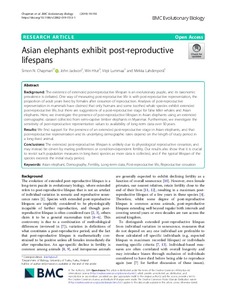Asian elephants exhibit post-reproductive lifespans
Chapman SN; Jackson J; Htut W; Lummaa V; Lahdenperä M
Asian elephants exhibit post-reproductive lifespans
Chapman SN
Jackson J
Htut W
Lummaa V
Lahdenperä M
BMC
Julkaisun pysyvä osoite on:
https://urn.fi/URN:NBN:fi-fe2021042821245
https://urn.fi/URN:NBN:fi-fe2021042821245
Tiivistelmä
Background The existence of extended post-reproductive lifespan is an evolutionary puzzle, and its taxonomic prevalence is debated. One way of measuring post-reproductive life is with post-reproductive representation, the proportion of adult years lived by females after cessation of reproduction. Analyses of post-reproductive representation in mammals have claimed that only humans and some toothed whale species exhibit extended post-reproductive life, but there are suggestions of a post-reproductive stage for false killer whales and Asian elephants. Here, we investigate the presence of post-reproductive lifespan in Asian elephants using an extended demographic dataset collected from semi-captive timber elephants in Myanmar. Furthermore, we investigate the sensitivity of post-reproductive representation values to availability of long-term data over 50 years. Results We find support for the presence of an extended post-reproductive stage in Asian elephants, and that post-reproductive representation and its underlying demographic rates depend on the length of study period in a long-lived animal. Conclusions The extended post-reproductive lifespan is unlikely due to physiological reproductive cessation, and may instead be driven by mating preferences or condition-dependent fertility. Our results also show that it is crucial to revisit such population measures in long-lived species as more data is collected, and if the typical lifespan of the species exceeds the initial study period.
Kokoelmat
- Rinnakkaistallenteet [27094]
